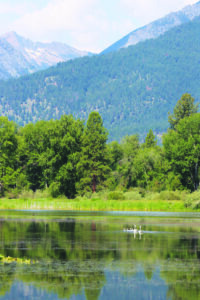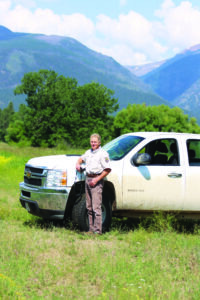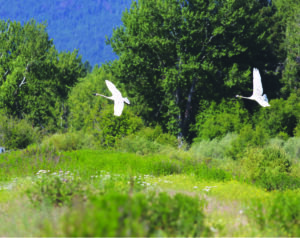
by John Dowd
Tom Reed has been with the Lee Metcalf National Wildlife Refuge for 13 years. When he started there as manager, there were 13 staff, including seasonal help. Now, there are only three people, including one part-time employee. According to him, the refuge seems underutilized for what it could be.

The refuge, just north of Stevensville, was created due to the late U.S. Senator Lee Metcalf, who was from Stevensville, and even went to high school there. It was financed by federal duck stamp money, and built upon purchased homesteads. The funds were secured in 1962, and land started being purchased in 1963. Currently, the refuge is 2,871 acres, and is always working to expand.
The original goal, and current focus, for the refuge is to manage primarily for migratory birds. The secondary goal was to provide for public use. The refuge is open to six wildlife dependent uses, including hunting, fishing, observation, photography, interpretation and education.
With the primary goal of waterfowl conservation and management, other programs have seen less attention and funding due to government cutbacks, according to Reed. He explained that the refuge used to have several education outreach programs. He said, however, “We are not doing those things to the degree that we once did them.” One such program still around, but waning, is the youth federal duck stamp art competition, which Reed is the state organizer of.
Those retired programs filled the education and interpretation spaces, but now, according to Reed, most of the use the place sees is observation and photography, with hunting in the fall.

“Birdwatching is huge at the refuge,” said Reed. That makes sense, due to the nearly 270 verified species of birds that call the refuge home, and with over 105 of those documented to be nesting in the space. Most recently, the refuge has been the proud host of a family of trumpeter swans that have been nesting there for the last five years. This is the first time and place the species has been recorded nesting in the valley. They are extremely picky birds, being large, white and easy to target by predators. According to Reed, the birds will choose an area of certain criteria including remoteness, availability of food sources, brood cover and more.
Reed recommends checking out the Kenai Observation Deck, which can be reached on a trail that leads away from the visitor center to the north. It overlooks several of the wetland impoundments, which are reservoirs that can be controlled by refuge staff throughout the year. These aid in creating prime habitat for local and migratory species. One such species, that can possibly be viewed from the observation deck, is the swan family, which have found their home in a far back reservoir. Reed also recommends bringing insect repellant to that area, and all over the refuge.
There are no fees to enter and use Lee Metcalf National Wildlife Refuge, and the refuge is open to the public. However, there are restricted areas. This is especially true during hunting and fishing, where certain areas are protected. The refuge is open from dawn until dusk.
The refuge also has a visitor’s center with numerous sources of information, including pamphlets and books, along with souvenirs and many taxidermied animals known to inhabit the refuge.
Reed explained that he loves the refuge because, “I enjoy everything about wildlife and seeing people get excited and enjoying wildlife.” He wishes the refuge would get more attention for the great work they are doing, as well as more visitation to spread the love and interest of wildlife conservation and enjoyment.
Bob says
John, your writing skills are poor. Did anyone proof read your work? Please take an English composition class at your local community college prior to attempting to write anything for publication.
A retired teacher.